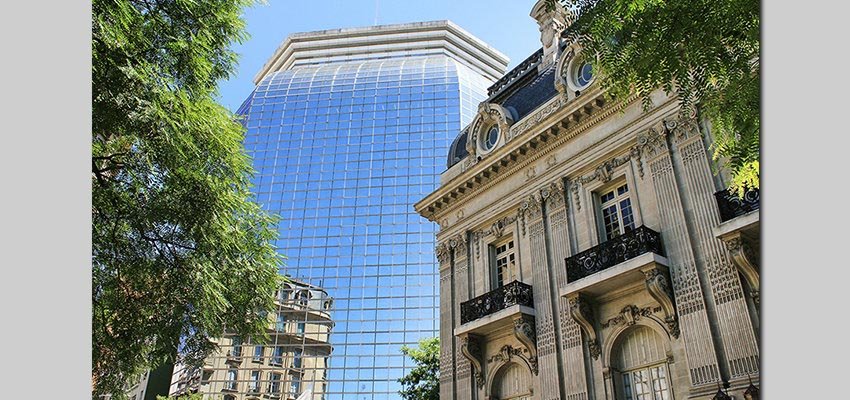The “Paris of Latin America”: discovering the architectural highlights of Buenos Aires (private tour)
Buenos Aires is commonly called the "Paris of Latin America," due to the ubiquity of Art Nouveau and other classic French style buildings in many areas of the city. Besides this, the city is home to an eclectic, original, and distinguished collection of architectural pieces ranging from colonial to classic to modern styles that are a testament of the cultural heritage brought by the colonizers and immigrants of Buenos Aires.
Our explorations will start at the financial center, commonly referred to as "Microcentro." We will walk here for about half an hour appreciating architectural pieces with classic French and Italian influences. First, we'll see buildings whose designs were inspired by the romantic belle époque era, before making our way to one of the most original and bold manifestations of architecture in Buenos Aires: Banco Hipotecario (Mortgage Bank). This architectural gem is an example of brutalist architecture, a style of building that is known for not being the prettiest. Its abstruse rectangular structure designed with reinforced concrete was built in the 60's and is one of the most unique buildings in the city. As we admire the imposing concrete building, we'll be left wondering whether it's a beautiful piece of art or an eyesore!
Next, we'll drive to the Avenida de Mayo (May Avenue). Often compared to La Gran Via in Madrid (Spain), this sophisticated neighborhood is famous for its varying architectural styles.
We'll walk for one block, noticing the Neoclassical and Art Nouveau-style buildings that line the street. One building you will certainly notice is the former headquarters of La Prensa Newspaper. This large and imposing building is also known as the Casa de la Cultura (the Buenos Aires House of Culture), and was declared a National Historic Monument in 1995. If you look up high, you'll be able to see a distinct feature, the spire on top of the building, which is a gilt bronze monument dedicated to the freedom of the press.
Then we will come to the famous Café Tortoni, Argentina's first and arguably most chic café, founded in 1858. This cultural café was named after the Parisian café Tartoni and has a strong French influence in its design. Historically, the café is where many of Buenos Aires' famous personalities met to discuss and partake in cultural activities. It has been a favorite haunt of tango singing sensation Carlos Gardel, and also of Argentina's most celebrated writer: Jorge Luis Borges. Even international personalities like Albert Einstein enjoyed a coffee in this iconic café.
As we continue along the diverse Avenida de Mayo, we'll come across the Barolo Palace. This commanding structure illustrates and pays tribute to the "Divine Comedy" written by Dante Alighieri. Its architect, Mario Palanti, was a scholar of the Divine Comedy and filled the palace with references to it. The general building (as in the Divine Comedy) is divided into three parts: Hell, Purgatory and Paradise. This building shows a unique architectural style, mingling the neo-Romanesque and neo-Gothic appearance, followed by the dome with its original Hindu design dedicated to love and symbolizing the union of Dante with his beloved Beatrice. The care in the details gives the palace a unique sense of character that gives it a story all its own.
Another prominent building on the avenue is the Palace of the National Congress. This white-marble, neoclassical building is the seat of the National Congress of Argentina and has always been a central spot of political life in Argentina.
As we reach the corner of the Avenida de Mayo, we'll see the Hotel Chile, a building that is one of the best surviving examples of the Art Nouveau style in Buenos Aires. We'll also pass the former headquarters of the Critica Newspaper, a prominent example of Art Deco architecture.
We'll then walk along Belgrano Avenue, stopping briefly to admire the Otto Wulf Building that's built in the Jugendstil style, a German version of Art Nouveau. It was built between 1912 and 1914 by commission of the Austro-Hungarian Empire's ambassador to hold its embassy and office, which were not needed just a few years later, when the Austro-Hungarian Empire was dissolved at the end of World War I! The building has eight human figures that appear to be holding the building on their backs, and each has a different face which corresponds to the workers involved in the building's design and construction, including its architect.
This afternoon private tour will start go from 1 to 4 PM, to then head to the international airport to get your international flight back home.
Difficulty: none.
Duration: 3 hours.
Guide: private guide.
Vehicle: private vehicle.
Includes: Entrance tickets where needed.
 Buenos Aires is home to an eclectic, original, and distinguished collection of architectural pieces
Buenos Aires is home to an eclectic, original, and distinguished collection of architectural pieces





